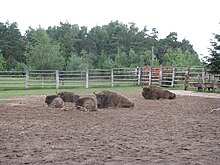Mellenthin Heath
The Mellenthiner Heide is an area south of the municipality of Mellenthin in the interior of the island of Usedom . Contrary to its name, it is largely not a heathland , but a closed wooded area and in some places moor . The area is crossed by the federal highway 110 , borders on the Usedom city forest to the west and extends to the south almost to the Stettiner Haff . Its biggest attraction is a bison reserve .
history
The area shares the history of the municipality of Mellenthin .
From the mid-1930s, the marine ammunition depot for the flak batteries in Central Pomerania was built in the eastern part of the heath. It consisted of a widely ramified bunker system, numerous warehouses and accommodations for forced laborers of different nationalities. After the war ended, the facilities were blown up by the Red Army . Today, the area is (partially) used by the ammunition dismantling company of the state of Mecklenburg-Western Pomerania and is closed to the public. The extensive network of paths in the rest of the forest area between the main road and the villages on the Stettiner Haff ( Stolpe auf Usedom , Gummlin, Prietenow and Dargen ) is accessible to cyclists and hikers.
The area has been part of the Usedom Island Nature Park since 1999 .
European bison reserve
Since July 2004 there has been a bison reserve of around 6 ha in size near Pratenow . The first 4 animals were a gift from the Ministry of the Environment in Warsaw and come from various Polish national parks .
In the wild in Pomerania , bison were already extinct at the end of the 14th century; The last aurochs is documented on the island of Usedom in 1364.
As early as the GDR times (1979), representatives of the national park on the Polish neighboring island of Wollin , where there had been a bison open-air enclosure since 1976 , expressed interest in a cooperation with the island of Usedom. However, this first initiative was not supported by the responsible district administration in Wolgast or the district administration in Rostock and ended with the closure of the border in 1981. It was not until 1999, when nature conservationists came again from the island of Usedom to go on an excursion to the Wollin National Park picked up again. When looking for a location, the forest area of the Mellenthiner Heide, which is not very well developed for tourism, was considered particularly suitable. Approval was granted in November 2003; In January 2004, the construction of the show enclosure could begin, which was completed in the summer. One bull and three cows were imported from the Polish jungle of Białowieża . The last European bison lived in the wild in Bialowieza before they were exterminated there in 1919. It was not until 1952 that the bison returned to the jungle after being rescued at the last minute through an international breeding program. The Usedom bison enclosure will be expanded in 2009 with a permanent exhibition and an information house. This means that the Usedom bison enclosure also has bad weather and is open all year round. All information in the enclosure is in German and Polish.
